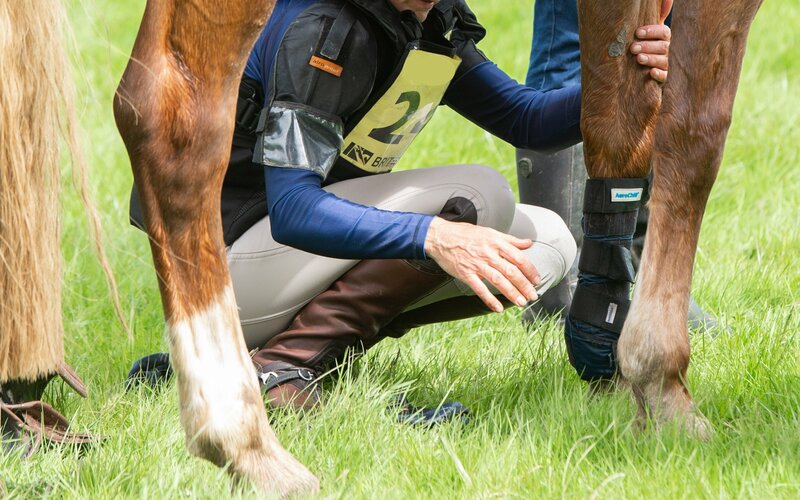
Caring for your horse’s cuts and wounds
Unfortunately, dealing with wounds is a common practice for the majority of horse owners. Knowing the different types of wounds and how each should be treated will ensure a quick recovery and minimise the risk of infection. So, how do you identify each type of wound?
Open wounds fall into four categories:
Open wounds fall into four categories:
- Incised wounds
- Lacerations and tears
- Punctures
- Abrasions
Incised wounds often bleed heavily, have straight edges and are caused by the skin being penetrated by a sharp object. Causing little bruising, an incised wound is best suited to stitching, stapling or gluing and will usually heal relatively quickly.
Lacerations and tears are the most common type of wound caused by barbed wire fencing and have a torn, jagged appearance with some bruising. This type of wound is more susceptible to infection because of the degree of soft tissue injury.
Puncture wounds can be tiny and hard to spot but there is usually a tiny trickle of blood or a highly sensitive area around the puncture. Very little blood comes from a puncture wound, unless it has perforated a major blood vessel, which can be serious.
Abrasions are superficial skin wounds, such as saddle sores and grazes, often only involving the skin and hair. Other than a thorough clean, this type of injury usually requires minimal treatment.
Assessing and Cleaning Wounds
The first thing to do if your horse incurs an injury is to assess it, ensuring it doesn’t involve a synovial cavity such as a joint, tendon sheath or bursa, and decide whether a vet is required.
Once you are happy you can treat it yourself, next ensure it is free from any debris and foreign bodies to prevent infection by gently but thoroughly washing the wound with cold water, which will also reduce swelling.
If possible, clip the coat around the region of the wound area.
You can use a mild, diluted (as instructed) antiseptic solution such as Hibiscrub to clean the wound edges, and a sterile saline solution to lavage the wound.
Using a saline solution (level teaspoon of salt dissolved in a pint of previously boiled water) soak a piece of cotton wool and use it to thoroughly clean the wound, taking care to wipe the dirt out and not rub it in. A clean piece of cotton wool should be used for each wipe and the contaminated cotton wool should never be placed back in the solution or water.
Even a minor wound should be cleaned as soon as possible to remove any foreign bodies and reduce the risk of infection.
Assess the wound carefully to try to discover the cause, as there may be foreign bodies hidden below the wound surface.
Protecting the Wound
Once you are happy that the wound is clean, apply a wound gel, such as Intrasite Gel or hydrogel, before applying a dressing and bandaging.
It’s also worth discussing your horse’s tetanus vaccination with your vet to ensure he is up to date, particularly in the event of puncture wounds and injuries involving foreign bodies.
Change the dressings as instructed by your vet and monitor the wound until it heals fully. Be on the look out for proud flesh (thick, lumpy flesh) – call your vet if you are concerned.
If the wound isn’t healing well or quickly, or your horse is getting progressively more lame, there may be a more serious underlying issue and you should call your vet.
Signs of Infection
The aim of keeping a wound clean and protected is to prevent infection, which can delay healing and cause further problems. If a wound does become infected, what are the signs of infection?
- Heat in the area of the wound.
- Increased pain after a few days following the injury.
- Reddened skin.
- An unpleasant smell coming from the wound.
- Green or yellow pus or fluid oozing from the wound.
- Swelling that increases after the initial irritation has gone down.
If you are concerned that the wound has become infected, call your vet immediately as they may need to administer antibiotics.
Dealing with wounds is an unfortunate part of horse ownership, but if dealt with quickly and effectively they can be prevented from developing into a serious problem.
When to call the vet for your horse's cut
- If the wound is large, deep or bleeding profusely.
- If the eye is injured.
- If the wound is near a joint or tendon sheath. If there is a clear, sticky discharge coming from the wound, call your vet immediately – it could be synovial fluid from a joint or sheath.
- If an object such as a fence post or nail has penetrated your horse.
- If your horse is lame – there may be damage to the underlying bone, which could be more serious than the visible wound.
- If the horse has been kicked.
- If lameness gets worse.
- If the wound isn’t healing, is infected or worsens.
- If proud flesh develops.
Wound products
Animalintex
Animalintex is a multi-layered poultice and wound dressing, which can be applied either as a wet, hot or cold poultice, or as a dry dressing. It contains an antiseptic to clean and prevent re-infection, and a natural poulticing agent to draw out any infection.
From £5.50
From £5.50
Vetalintex Wound Hydrogel
Vetalintex Wound Hydrogel promotes wound healing by maintaining excellent hydration and offering a gentle cleansing action.
From £4
From £4
NAF EquiCleanse
Designed for safe and effective wound management and proven to kill 99.9 per cent of all known germs dead. Used either neat or diluted in water, EquiCleanse offers a veterinary level of hygiene when cleansing minor wounds.
From £9.99 for 500ml
From £9.99 for 500ml
NAF Arnica Gel
Arnica Gel is a smooth, cooling gel to soothe minor strains, sprains and bruising following muscular exertion, a knock or a blow.
From £12.99 for 400g
From £12.99 for 400g
NAF MSM Ointment
A thick, lanolin-based ointment, MSM Ointment provides a protective barrier to minor wounds while supporting the skin’s natural healing process.
From £13.99 for 250g
Please check with your vet regarding prohibited substances and
Advice from Andrea Bradshaw, Product Manager at Robinson Animal Health Care and vet Sue Taylor.
First published in the 2019 Nov/Dec issue of British Eventing Life, original words by Stephanie Bateman
From £13.99 for 250g
Please check with your vet regarding prohibited substances and
Advice from Andrea Bradshaw, Product Manager at Robinson Animal Health Care and vet Sue Taylor.
First published in the 2019 Nov/Dec issue of British Eventing Life, original words by Stephanie Bateman
